Last Updated on June 15, 2025 by Jay Maran
Getting your UK driving license is a thrilling milestone – but as I recently discovered firsthand, it can also feel like running a gauntlet. Imagine finally ditching those L-plates and gaining the freedom to drive anywhere in the UK. Sounds great, right? Well, if you’re in a big city like London, the path from learner to fully licensed driver involves patience, persistence, and a few hacks I wish I’d known earlier. In this guide, I’ll walk you through how to get a UK full driving license step by step, blending official requirements with personal insights from my own journey. By the end, you’ll know exactly what to do – and what pitfalls to avoid – on your way to becoming a licensed UK driver. Let’s get started!
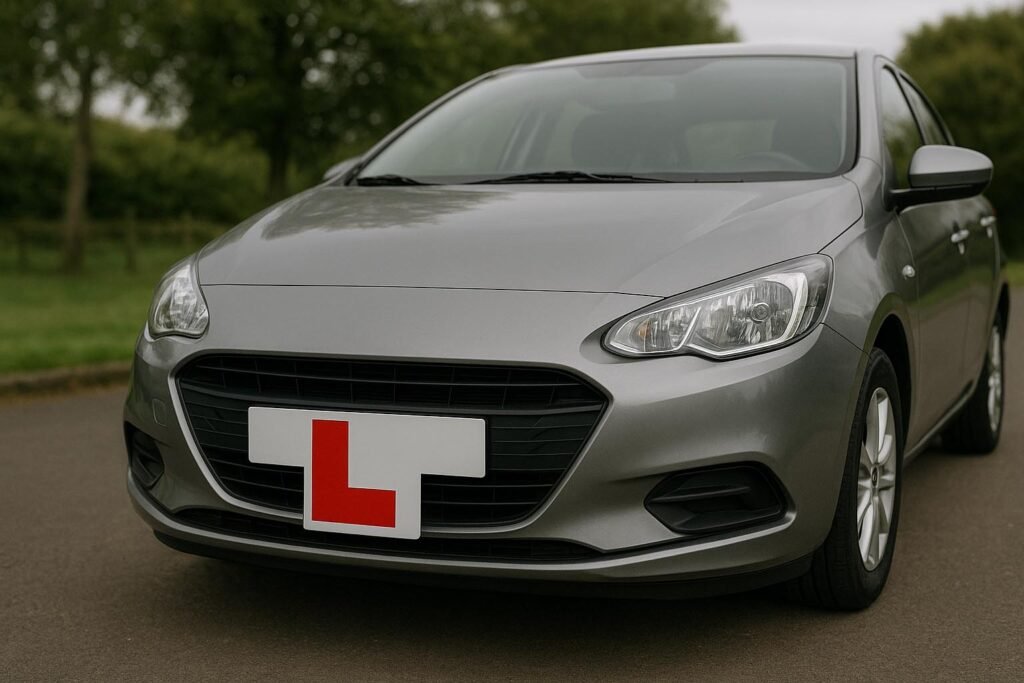
Step 1: Apply for Your Provisional Driving License – The Foundation
Every great journey begins with a single step. In this case, it’s applying for your provisional driving license. Without a provisional license, you can’t legally drive on public roads or book your theory and practical tests. Here’s what you need to know:
Eligibility Requirements:
You must be at least 15 years and 9 months old to apply, but you can only start driving a car at 17. Crucially, you need to have lived in the UK for at least 185 days in the past 12 months (about 6 months) – this residency rule catches many newcomers off guard. (In my case, I had to wait until I’d been in London for half a year before I could even begin the process!). You’ll also need to meet the minimum eyesight standard (reading a number plate from 20 meters away) and have no disqualifications.
How to Apply (Online vs. Post): There are two ways to get your provisional license:
Apply Online: This is the fastest option. Head to the official GOV.UK website to apply online (you’ll need a valid UK passport or other accepted ID). The fee is £34 for an online application. If you’re not using a UK passport for ID – for example, I used my foreign passport and biometric residence permit (BRP) – you’ll have to send your original identity documents by post after completing the online form (Yes, it’s nerve-wracking to mail your passport/BRP; I sent mine by tracked delivery with a prepaid return envelope, as many recommend on forums.) The good news: I got my documents back within about a week and my shiny new provisional photocard license arrived just a few days after that. In many cases, online applications are processed in about one week.
Apply at the Post Office: Alternatively, you can fill out a D1 paper application form (available at larger Post Offices or by ordering from DVLA) and apply for your provisional driving license by post. You’ll need to attach a passport-style photo and original identity documents (like your passport or residence permit) if you go this route. The postal application costs a bit more – £43 by cheque or postal order and it can take up to 3 weeks to get your provisional license by mail. If you’re not in a rush, this works fine, but most people (myself included) prefer the online method for speed.
What the Provisional License Allows:
Once you have that green provisional photocard in hand, you’re officially a learner driver! You can now practice driving on UK roads with some conditions. You must display L-plates on the front and back of any car you drive, and you must be supervised by a driver who’s over 21 and has held a full UK license for at least 3 years. No solo drives yet – your supervisor (whether an instructor or a family member/friend) is legally responsible for guiding you. Also, learner drivers cannot drive on motorways unless accompanied by an approved instructor. It sounds strict, but these rules are there for everyone’s safety. In my experience, having a supportive friend or instructor in the passenger seat not only kept things legal but also did wonders for my confidence in those early drives.
Tip – Get Insured: Don’t forget that you need proper learner driver insurance on any car you practice in. If you’re learning in a family member’s car, you’ll want to either be added to their policy or get a separate short-term learner insurance. Many insurers offer flexible learner insurance (e.g. one month at a time) to cover you without affecting the car owner’s policy.
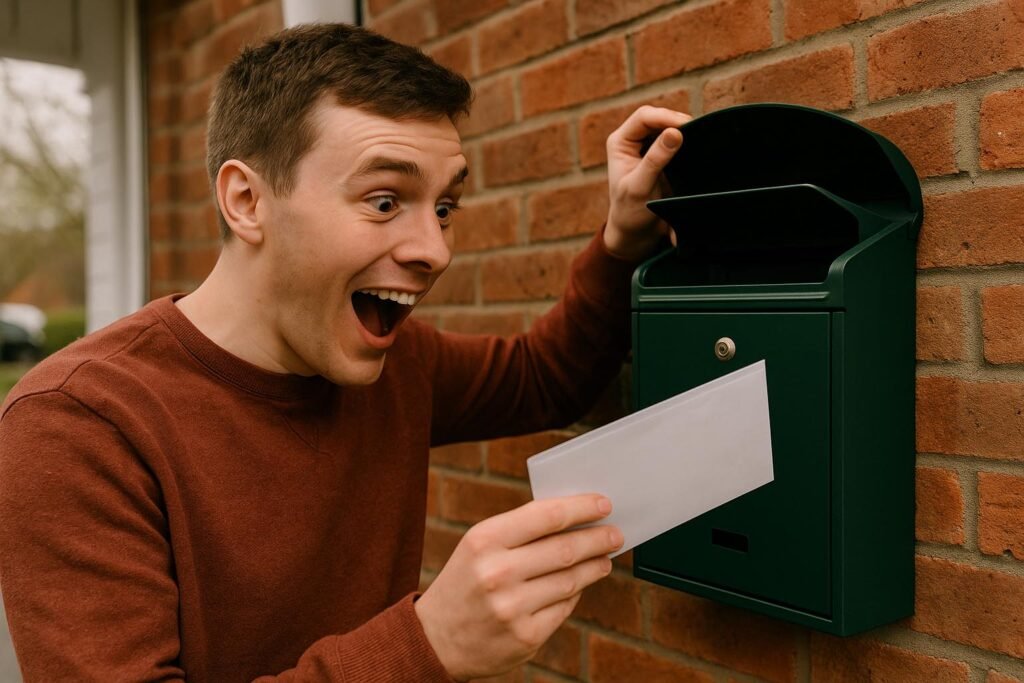
Step 2: Pass the Theory Driving Test – What to Study and Expect
With your provisional license sorted, it’s time for the next milestone: the driving theory test. This is a computer-based exam that tests your knowledge of the Highway Code, road signs, and driving scenarios, as well as your hazard perception skills. Here’s how to navigate this stage:
Preparing for the Theory Test
Don’t underestimate the theory exam – it requires solid preparation. The test has two parts:
1. Multiple-Choice Questions: 50 questions on road rules and driving theory. You need 43 out of 50 correct to pass this section (that’s 86%).
2. Hazard Perception: 14 video clips of real road scenes in which you must click when you spot developing hazards. The maximum score is 75, and you need at least 44 out of 75 points to pass. Essentially, you must be alert to potential dangers (like a pedestrian about to cross or a car emerging from a junction). Quick reactions score higher points.
I found the multiple-choice part straightforward after a few weeks of study, but the hazard perception was a new skill to learn. To prepare, I highly recommend using the official DVSA materials or apps. The DVSA Theory Test Kit app (available for a few pounds on iOS/Android) has a large question bank and realistic hazard perception videos. There are also free mock tests on the DVLA’s website and tons of YouTube videos explaining common hazard perception clips. On average, the RAC suggests learners spend around 20 hours revising for the theory test, using a mix of the official Highway Code, practice question banks, and video clips. In my case, I studied a bit each night for about two weeks. By test day, I had taken so many practice exams that the real thing felt surprisingly manageable.
Booking Your Theory Test
You can book the theory test online at the official site for a £23 fee. There are theory test centres all over the country. One perk here: theory test slots are usually easy to find at short notice. When I went online to book, I was pleasantly surprised – there were multiple slots available the same week! I snagged a convenient time for the following week at a test centre in central London. If you’re ready, you usually won’t have to wait long for a theory appointment (unlike the practical test – more on that headache later).
Test Day – What to Expect
For the theory test, you’ll need to bring your provisional photocard for ID. The exam is taken on a computer at the center with headphones provided (the hazard clips have sound). The multiple-choice section comes first. You’ll have 57 minutes to answer 50 questions – plenty of time if you’ve prepared. After a short break, the hazard perception starts: you watch each clip and click the mouse whenever you spot a hazard developing. Only one clip will have two hazards; the rest have one each. Pro tip: Don’t click in a rhythmic pattern or excessively – the system might flag you for cheating if you click nonstop. Instead, watch the road like you would in real life and click when you see a potential hazard (e.g., a car door opening ahead or a cyclist swerving). I treated it like a real drive, scanning for trouble.
Passing the Theory Test
You get your results immediately after finishing. It’s printed out for you at the test center. To pass overall, you must pass both the multiple-choice and hazard perception sections. If you pass (congrats!), you’ll receive a pass certificate with a number on it. Keep this safe – you’ll need that certificate number to book your practical driving test. (I stuck mine on the fridge with a magnet until it was time to use it.)
The theory test pass is valid for 2 years. That means you have two years to take and pass your practical test, or else you’ll have to retake the theory exam. Two years sounds like ample time, but as many learners are finding out, long waits for practical tests can eat up a chunk of that window (so don’t delay booking your practical once you’re ready). If you don’t pass the theory, don’t be discouraged – you can retake it after a minimum of 3 working days. Use the feedback on which questions or hazard clips you got wrong to guide your studying, then try again.
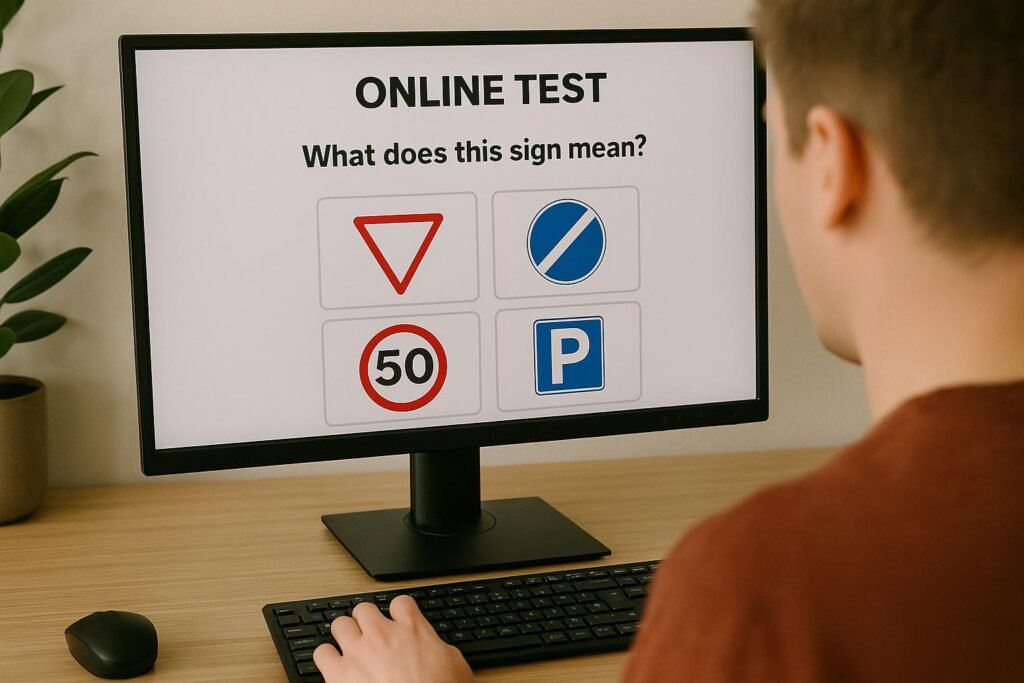
Step 3: Prepare for the Practical Driving Test – Lessons, Tips, and Cost
With the theory test behind you, the real hands-on learning begins. This stage is all about building your driving skills through lessons and practice so that you’re ready for the practical test. Here’s how to make the most of it:
Professional Driving Lessons
While not strictly mandatory in the UK, professional lessons with an approved driving instructor are highly recommended – especially if you’re new to driving. A good instructor will teach you proper techniques, safe driving habits, and all the test maneuvers to ensure you meet the DVSA standard. On average, the DVSA finds it takes around 45 hours of professional lessons (plus additional practice privately) for a learner to reach test-ready standard. This is just an average – some people need more, some less. For example, if you’ve driven in another country before, you might progress faster.
In my case, I had some driving experience back home, so after about 15 hours of lessons my instructor felt I was nearing test-ready (though UK roads and rules still had plenty to teach me!).One thing to note is the cost: lessons aren’t cheap, especially in big cities. Prices vary by region and instructor, but expect to pay roughly £25–£40 per hour of lesson. In London, I paid £35/hour with an independent instructor; national driving schools like AA or Red were quoting around £40/hour in my area for manual car lessons. Some instructors offer discounts if you book a block of lessons (e.g. 10 hours package). It definitely adds up – the RAC estimates about £1,500 total for the average learner’s lessons.
However, consider it an investment in skills that will keep you safe on the road for life. Also, spreading lessons out (say, 2 hours per week over a few months) can help financially and give you time to absorb what you learn between sessions.
Private Practice
In addition to formal lessons, getting in extra practice with a family member or friend can be incredibly helpful (and free!). If you have access to a car and a willing accompanying driver (who meets the requirements: over 21, full driving license for 3+ years, and of course the car must be insured for you), use that opportunity. Practising in different traffic conditions, at night or in bad weather, and on varied routes will improve your confidence. The government suggests most learners benefit from about 20 hours of private practice on top of lessons. I used to go out driving with my cousin on weekends; it was a low-pressure way to refine my skills – plus, driving the same car I’d eventually use for the test (my instructor’s car) helped me get really familiar with its clutch and bite point.
Key Skills to Focus On
During lessons, you’ll cover a checklist of skills that examiners will expect you to demonstrate. These include:
Manoeuvres: Master the standard manoeuvres: parallel parking, parking in a bay (forwards and reverse), and the “pull up on the right and reverse” exercise. You might not be asked to do all of them on your test – typically it’s one manoeuvre at random but you need to be comfortable with each. Take it from me: practice these until they feel routine. I spent an entire lesson just drilling bay parks because that was my weak spot.
General Driving Skills: You should be able to confidently move off and stop, use mirrors and signals correctly, handle junctions (open and closed junctions, roundabouts, etc.), and maintain good lane discipline. In lessons, I found things like judging safe gaps or planning ahead in heavy traffic were things that only came with experience. Don’t rush your learning; it’s better to reschedule your test than to take it unprepared.
Defensive Driving: Good instructors will also teach you to anticipate hazards and drive defensively. Remember, by the time you take your practical test, you’re expected to drive with the same awareness and adherence to rules as a safe qualified driver. That means observing speed limits, keeping safe following distances, yielding where appropriate – all the real-world good habits. If you’re consistently making a particular mistake (say, missing mirror checks when turning), work on it until it’s fixed. The DVSA’s data shows that the most common reasons for failing the test include poor observation at junctions and not using mirrors effectively, so focus on those core habits.
Listen to Your Instructor’s Advice
When you’re itching to get your full license, it’s tempting to rush into the test as soon as you’ve done “enough” lessons. But experience matters. My instructor had a policy: he wouldn’t let students use his car for the test until they consistently passed mock tests and he genuinely believed they were ready. Initially, I thought 10-12 hours might be enough since I had prior driving experience. He suggested a few more to iron out my UK-specific habits. In hindsight, I’m glad I took his advice – those extra hours might have saved me from failing for something silly like not checking blind spots. Remember, there’s no minimum number of lessons required in the UK to obtain your driving license – it’s up to you to be honest with yourself about your readiness. Use mock tests (some instructors offer a full 40-min simulated test) to gauge your progress.
Choosing Manual vs Automatic
One quick note – consider whether you want to learn in a manual (stick shift) or an automatic car. A manual driving license lets you drive both manual and automatic cars, while an automatic driving license restricts you to automatics only. Automatics can be easier to learn (no clutch control or gear changes to worry about), but automatics might be more expensive to buy or rent. I chose manual because I wanted the flexibility and manual cars are still very common in the UK. It meant a bit more to learn (oh, those early days of stalling at traffic lights…), but I’m happy I did it. Pick what suits your situation – just know your practical test will be in the type of car you’re learning in, and that determines your license type.
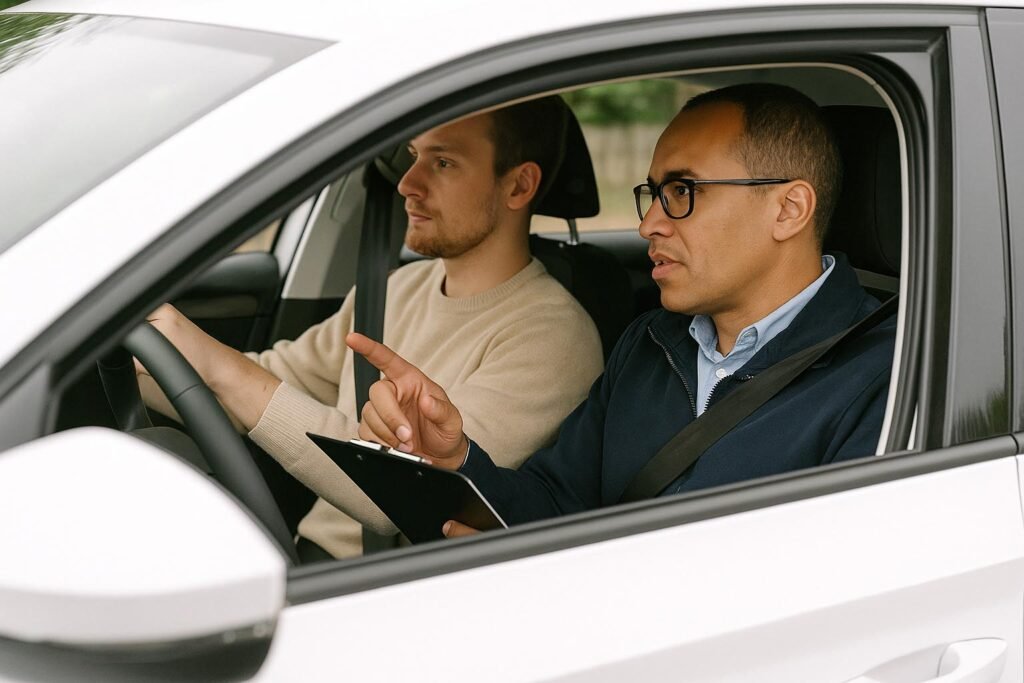
Step 4: Book and Take the Practical Test – What Happens on the Day
So you’ve honed your skills and feel test-ready – congratulations! Now comes one of the most frustrating parts of the UK licensing process today: booking your practical driving test. If you’ve heard horror stories about long waiting times, I can confirm they’re true. Here’s what you’re up against and how to navigate it:
The Great Test Slot Shortage:
In many areas of the UK (especially major cities like London), learners are facing huge waits to get a practical test date. As of early 2025, the average wait time in England is around 21 weeks (5 months), and in some places it stretches to 6+ months. When I first looked online for a test slot in my local London test centres, I was stunned – the earliest dates were nearly a year away! I tried every test centre within 25 miles and saw nothing sooner. This isn’t just our bad luck; it’s a nationwide backlog. A combination of high demand, a pandemic-induced backlog, and examiner shortages has led to fully booked calendars. The DVSA opens new test slots on a rolling basis (usually you can book about 24 weeks in advance), but they get snapped up within minutes of release. Try finding your slot availability – click here.
Why You Can’t Find a Test (and Who Is Finding Them)
You might wonder, “If I can’t find a slot, who is booking them all?” The answer often is driving instructors and third-party booking services – some of whom use software bots to grab cancellations or new slots the moment they appear. It sounds unfair (and frankly, it is). In my experience, every independent instructor I spoke to had a stash of pre-booked test appointments. They book slots as soon as they’re released, often under dummy student names, then later assign them to their actual students when ready.
This means the public system shows “no availability” while instructors hold the keys to earlier dates. Some “unscrupulous” third-party websites even resell test slots at a markup, exploiting learners desperate for a sooner test. The government is aware of these issues – in fact, new rules and anti-bot measures are being implemented to curb this abuse– but as of now, it remains a real headache for the average learner trying to book directly.
DIY vs Instructor Booking
Initially, I was determined to book the practical test myself online. After all, it costs £62 for a weekday test (or £75 for a weekend/evening) on the official system, and I thought with a bit of persistence I could snag a cancellation. I would obsessively refresh the DVSA booking website at odd hours, hoping someone had canceled a test. Weeks passed with no luck; it was like trying to buy concert tickets for a superstar – slots would flash available and disappear in seconds. Meanwhile, every instructor I spoke to said essentially: “I can get you a test next week if you take X hours of lessons with me.” This felt like a scam to me at first – why should I pay for extra lessons just to get a test date? But eventually, facing a 9-month wait on my own vs. potentially 1-2 weeks via an instructor, I caved.
I went with a local driving school that promised me a test “slot” in the coming month, provided I did at least 10 hours of lessons with them and paid a booking fee. Sure enough, as soon as my new instructor felt I was ready, he “released” one of his pre-booked slots and we grabbed it for the following week. I ended up paying a bit extra (the instructor charged me for the use of his car on test day, which is common – around £100 including an hour warm-up before the test and the car for the test itself). Was it fair? Not really. Did it work? Yes – I got my license months sooner.
Tips to Find a Test Sooner (If You Go Solo)
If you don’t want to go via an instructor’s pre-booked slot, there are a few strategies to try:
Use a Cancellation Checker App: There are smartphone apps and services that scan for canceled test appointments. Some are free with limited functionality, others charge a small fee. They basically constantly ping the DVSA system and alert you if an earlier date opens up. If you use one, be ready to act fast when it notifies you – you might beat the bots and instructors to grab that slot. (Just ensure any service you use is reputable; never pay a ridiculous sum to a shady site for a “guaranteed” test – there have been scams out there).
Refresh at Odd Hours: New test slots or cancellations often appear early morning or late at night when traffic is lower. I woke up early and checked at 6am and 11pm regularly. It’s a bit of a lottery, but some learners do strike gold with persistence.
Expand Your Radius: If you can travel, search for test appointments in other nearby towns or cities. It’s not ideal, but some people drive 50+ miles to a test center where the wait is shorter. Just be sure to practice in that area a little beforehand so you’re not completely unfamiliar with the roads. I considered a test center outside London with an earlier slot, but ultimately stuck with my local one through the instructor.
Keep Preparing in the Meantime: Importantly, use the wait time wisely. Keep practicing driving so you don’t get rusty. One upside of a longer wait is you have more time to refine your skills and make sure you’re truly test-ready. The worst outcome would be rushing to a test unprepared (even if you found a quick slot) and then failing – which would mean starting the whole waiting process over again. Remember, about 48-50% of candidates fail the practical test on the first try, often due to nerves or small mistakes. The more prepared and confident you are, the better your odds of passing and not having to endure the wait again.
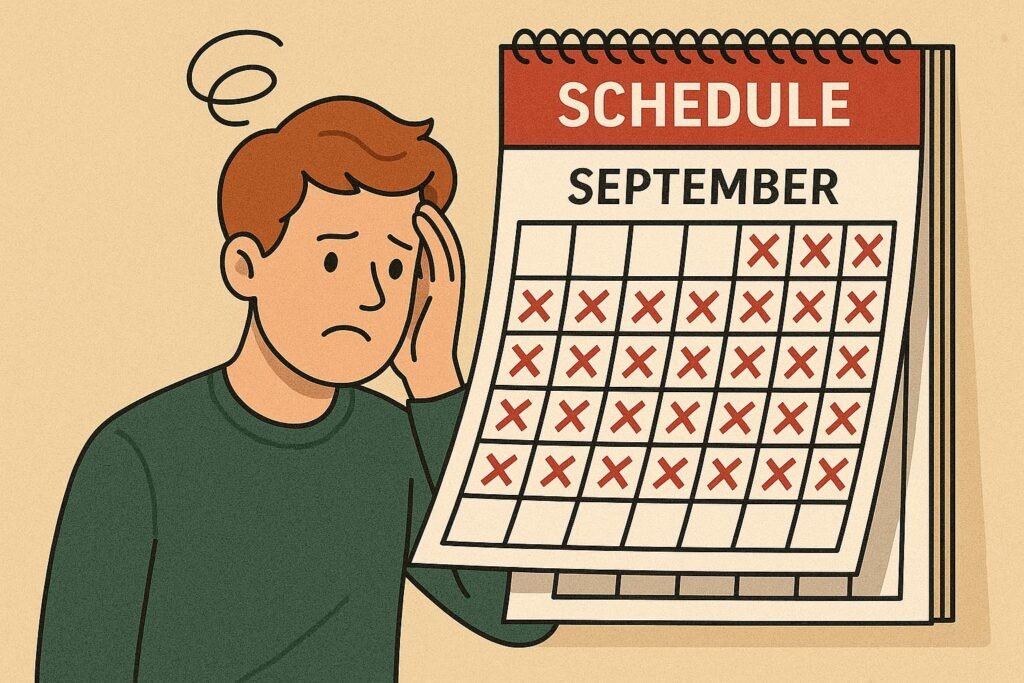
Step 5: Acing the Practical Driving Test – On the Big Day
You’ve got a test date (finally!) and have put in the hours of practice – now it’s show time: the practical driving test. This 40-ish minute road test is the last hurdle to getting your full UK driving license. It’s natural to feel nervous (I was terrified the night before mine), but knowing what to expect can really help calm the jitters. Here’s a breakdown of the practical test and some tips from my experience:
What to Bring to Your Test
Make sure you have your provisional driving license photocard with you – no license, no test! Also bring your theory test pass certificate (though they often have it on record, it’s good to have proof). If you’re using your own car (rare, but some do), it must be roadworthy, insured, have L-plates displayed, and you’ll need to provide an extra interior mirror for the examiner. Most people use their instructor’s car, which will meet all requirements. In my case, my instructor met me an hour before the test for a last-minute practice and to get the car clean and ready.
Test Day Conditions
Try to get a good night’s sleep and eat something light that morning – you need to be alert. I also did a quick mindfulness exercise to steady my nerves (deep breaths, visualizing a calm drive). Show up at the test center about 10 minutes early. Any earlier and you’ll just be sitting in the waiting room building anxiety; any later and you risk missing your slot. At the center, you’ll meet your examiner, they’ll check your ID and have you sign some paperwork. They might ask if you want your instructor to sit in the back during the test – this is optional. I opted not to, as I didn’t want an audience, but some learners like having their instructor there for moral support or feedback (they won’t intervene, they just observe).
The Eyesight Check
Before you even get in the car, the examiner will ask you to perform an eyesight check. You’ll need to read a standard UK number plate on a parked vehicle from a distance of 20 meters. It’s a simple test – just reading out loud the letters and numbers. If you normally wear glasses or contacts, be sure to wear them! (Failing the eyesight check means an instant end to the test, and you’ll have to reschedule once you sort out your vision or prescription). This step was over in a few seconds for me – I read the plate, the examiner nodded, and off we went to the car.
‘Show Me, Tell Me’ Vehicle Safety Questions
Next, before starting the engine, you’ll get one “Tell me” question from the examiner’s list of safety/maintenance questions. These are things like “Tell me how you’d check the brakes are working before a journey” or “Tell me how you’d check the tire pressures and where you’d find the info for recommended pressures.” You answer verbally. (The good news: if you get it wrong, it’s just a minor fault, not an automatic fail. So don’t panic – just answer as best you can.) During my test, I was asked to tell me how I’d check that the headlights and tail lights are working. I responded: “I’d turn on the car’s lights, then walk around the vehicle to visually inspect that all the lights are on.” That did the trick. Later during the drive, you’ll be asked one “Show me” question, which is performed on the move.
The examiner will say something like, “When it’s safe, show me how you wash and clean the front windscreen” or “show me how you’d open your side window.” You then actually do that action (in those examples, operate the washer/wipers, and press the window button, respectively). I was nervous about when this would happen, but it was fine – as I was driving down a straight road, the examiner asked, “Show me how you’d set the rear demister.” I quickly pressed the demister button. Done. Tip: If you’re unsure where a control is, ask the examiner to clarify before you start driving. They can’t help once you’re in motion, but they can explain the question beforehand if needed. And again, a wrong answer here is only a minor fault.
The General Driving Portion
Now comes the core of the test: actually driving. You’ll spend around 40 minutes driving in various road conditions. The examiner gives directions step by step (except during the independent driving phase, see below). They’ll take you through different scenarios: maybe some busy urban streets, perhaps a bit of faster road or dual carriageway, some residential areas, etc. They want to see you deal with whatever traffic situations arise calmly and safely.
During my test route, I encountered a bit of everything – a roundabout, a tricky hill start, a pedestrian crossing with someone who stepped out late, and even a rogue cyclist cutting in front of me. Expect the unexpected and just apply the good habits you learned. The examiner will ask you to perform a few routine tasks like pulling over to the side of the road and then pulling away again (possibly on a hill, or from behind a parked car) – this checks that you can move off safely under different circumstances (don’t forget those blind spot checks!).Importantly, keep your composure even if you make a mistake.
Not every mistake is a test-fail. If you stall the car or take a wrong turn, for instance, you can still pass as long as you stay calm and handle it safely. I actually stalled once leaving a junction (nerves!), but I restarted the car, took a breath, and carried on. The examiner didn’t seem fazed – and I still passed. They’re looking at the overall drive, not perfection.
Minor faults (like a hesitation or a slightly missed mirror check) are allowed up to a limit – you can have up to 15 minor faults and still pass, as long as there are no serious or dangerous faults. A serious fault is something that could potentially cause danger (e.g., if you consistently forget to check mirrors and it becomes hazardous), and a dangerous fault is one that actually did cause danger (say, the examiner had to use the dual brake to prevent an accident). Any serious/dangerous fault is an immediate fail, but a handful of minors (small mistakes) are expected even from otherwise good drivers. So if you grind a gear or misjudge a gap slightly, don’t mentally quit the test – chances are it’s just a minor. Keep focused and carry on.
Manoeuvres and Reversing
At some point, the examiner will ask you to perform one reversing manoeuvre. It will be one of these:
1. Parallel park behind a parked car on the side of the road.
2. Park in a parking bay (either driving in and reversing out, or vice versa – they’ll specify).
3. Pull up on the right-hand side of the road, reverse for about 2 car lengths, then rejoin traffic.
You won’t know which one until they ask, so practice all three beforehand. I got the parking bay maneuver – had to reverse into a bay in the test center’s car park at the end of the test. It wasn’t perfect (I had to adjust once), but I kept it slow and controlled. The key is observations: look all around for other road users before and during the manoeuvre. Move the car slowly. If it goes a bit wrong, you’re allowed to adjust – just don’t hit the curb or a parked car, obviously! The examiner just wants to see that you can carry out a low-speed maneuver safely.
Tip: Don’t panic if you think you’re too wide or misaligned; stop, take a breath, and reposition as needed. It’s far better to correct yourself (with proper observation) than to force it and mess up big time.There’s roughly a 1-in-3 chance you’ll also be asked to do an emergency stop exercise (they randomly include this in some tests). This is where the examiner asks you to pull over, then briefs you: “I will say ‘STOP’ and raise my hand; at that point, please perform an emergency stop.” If they do this during your test, just react promptly: clutch and brake together, firm controlled stop, then secure the car (handbrake, neutral). Remember to breathe – it’s over in a second. I didn’t have to do an emergency stop in my test, but I practiced plenty just in case.
Independent Driving (Following Sat Nav or Signs)
For about 20 minutes of the test, you’ll do independent driving. Most of the time nowadays this means the examiner will set up a sat nav in the car and ask you to follow its directions. (Don’t worry, they provide the sat nav and set the route; you won’t have to fiddle with it yourself).
In some cases, you might be asked to follow road signs to a particular destination instead. During this phase, the examiner generally stays quiet except to give the initial instruction. The idea is to drive as you normally would, following the sat nav’s prompts, without being directed at every turn by the examiner. If you mishear or get confused, you can ask the examiner to confirm a direction – they’re allowed to answer questions, just not to guide you proactively. And if you take a wrong turn (it happens, sat navs aren’t foolproof or maybe you miss a sign), it’s not an automatic fail! The examiner will simply redirect you or the sat nav will recalc.
They’re testing how you deal with driving independently, not your navigation skills specifically. I actually went the wrong way at a roundabout (took the third exit instead of fourth as the sat nav wanted), but the examiner calmly said, “That’s fine, we’ll adjust the route,” and we continued. I made sure to stay composed and safe during the detour, which is the main thing. So, focus on your driving, not on whether you’re on the “correct” route per the sat nav.
After the Drive – The Result
When you pull back into the test centre at the end, you’ll probably be dying to know how you did. Once the car is parked and engine off, the examiner will typically tell you straight away if you passed or failed, and go over any faults. This is usually done while you’re both still seated in the car. I’ll never forget hearing the words “I’m pleased to tell you that you’ve passed.” A wave of relief and joy washed over me – definitely one of the best feelings! The examiner then briefly mentioned a couple of minors I had (one for the stall, one for slightly late mirror check on a lane change) and gave some general safe driving advice.
If you pass, you’ll receive a pass certificate on the spot. Treasure it – you are now a licensed driver! The examiner will take your provisional driving license (to send off to DVLA) and you should receive your new full driving license photocard by post within 1-3 weeks. Mine arrived in about a week, surprisingly quick.If, unfortunately, you didn’t pass, the examiner will explain what went wrong and give you a report of faults. Take the feedback constructively – you can book another test after at least 10 working days. Many great drivers passed on their second or third attempt, so don’t be too hard on yourself. Tackle those problem areas and try again when you’re ready.
Celebrate Safely: Passing your driving test is a huge achievement – congrats! Now you can rip up those L-plates (or better yet, save one as a memento). You’re legally allowed to drive alone immediately, but one bit of advice: take it easy for the first few solo drives. It’s a big transition going from supervised to solo. I remember my very first drive alone after passing – it felt liberating but also oddly nerve-wracking not having someone in the passenger seat. Build up your confidence by choosing a familiar route for that first trip. And consider putting “P Plates” (the green P stickers) on your car to indicate you’re a new driver; it can make other drivers a touch more forgiving.
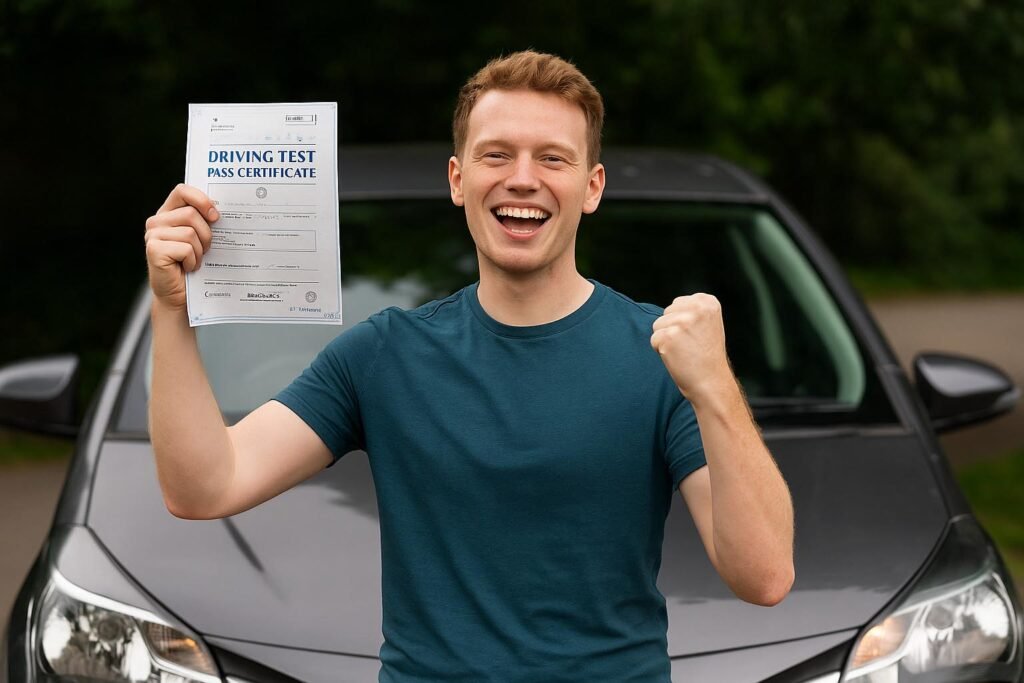
Key Insights and Final Tips for Getting Your UK Driving License
We’ve walked through the entire process, but before we wrap up, here are some key insights and tips to highlight, drawn from both my experience and expert advice:
- Plan Ahead and Be Patient: The UK driving license process isn’t something you complete in a week or two. There are mandated waiting times (185 days residency, 6 months+ for tests in many areas) and it often takes learners several months of practice to be truly ready. Start early if you’re aiming to get licensed by a certain date.
- Cost-Saving Hacks: Learning to drive can strain the wallet. To save money, make use of free resources like online theory practice and YouTube tutorials for maneuvers. If you have a willing family member with a car, do as much private practice as possible (following all legal requirements) – it can cut down the number of paid lessons needed. Also, consider booking lessons during off-peak times; some instructors charge less on weekdays midday compared to evenings or weekends. And if you’re a student in London, don’t forget you might not need a car immediately – the public transport here is excellent.
- Stay Safe and Keep Learning: Passing the test doesn’t mean you know everything about driving. In fact, the real learning begins once you’re on the road solo. Keep up good habits, consider taking the Pass Plus course or additional motorway lessons if you only learned in the city. The UK has varied driving conditions – country roads, busy urban centers, different weather – so continue to build your expertise. Personally, I’m still learning every day. The goal is not just to get a license, but to be a competent, safe driver for life.
- Mind Your Mental Game: Nerves play a big role, especially on test day. Develop techniques to manage stress – whether it’s practicing mock tests to build confidence, using breathing exercises, or even something like positive visualization. On my test day, I told myself, “No matter what, I’m going to drive as safely as I can. If I make a mistake, so be it.” That mindset kept me relaxed enough to actually perform well. If anxiety is a major issue, talk to your instructor; they have lots of experience with nervous learners and can offer coping strategies (for instance, taking the examiner or a family member in the car during a mock test to simulate pressure).
- Regulatory Changes: The driving test and licensing rules do evolve over time. For example, in 2025 there’s been talk of measures to reduce waiting times and prevent bots from hogging slots. Always double-check the latest official guidance when you start the process – requirements for ID, test fees, etc., can update. The GOV.UK website and the DVSA’s “Ready to Pass?” campaign are great sources for up-to-date info (and they bust a lot of myths too).
And finally: enjoy the journey! Learning to drive is a memorable experience. You’ll have frustrating days (parallel parking made me want to scream at times), but you’ll also have triumphant moments (like the first time you nail a hill start or navigate a roundabout smoothly). Take pride in each milestone – provisional in hand, theory passed, that first time driving on a busy road – they’re all steps toward the independence a full driving license will give you.
Conclusion: Your Road to Freedom
Earning my UK driving license was by no means easy – but was it worth it? Absolutely. That feeling of holding the full license, knowing I could legally drive myself anywhere from the Scottish Highlands to the Cornish coast, was incredible. I won’t miss the bureaucracy and the waiting, but I’m grateful for the skills I picked up along the way and the stories I can now share (yes, even the saga of the elusive London test slot!).
If you’re about to embark on this journey, go for it with confidence and determination. Use this guide, listen to experienced voices, and don’t rush – safe and skilled is the goal, not just passing a test. Before long, you’ll swap those L-plates for P-plates, and soon after, you won’t need any plates at all – you’ll just be another capable driver on the road.
Good luck on getting your UK driving license, drive safe, and maybe give a nod or smile to the next learner you see struggling with a three-point turn – we’ve all been there!
Have questions or your own experiences to share about the UK driving test? Drop a comment below – let’s help each other out. And if you found this post useful, feel free to share it with others learning to drive. For more tips on living your best London life (on wheels or off), check out our other guides like the How to Get a Student Oyster Card in London and Cheap Ways to Travel in London for savvy travel savings. Now, buckle up and enjoy the ride – the road to your full license is waiting! 🚗🎉

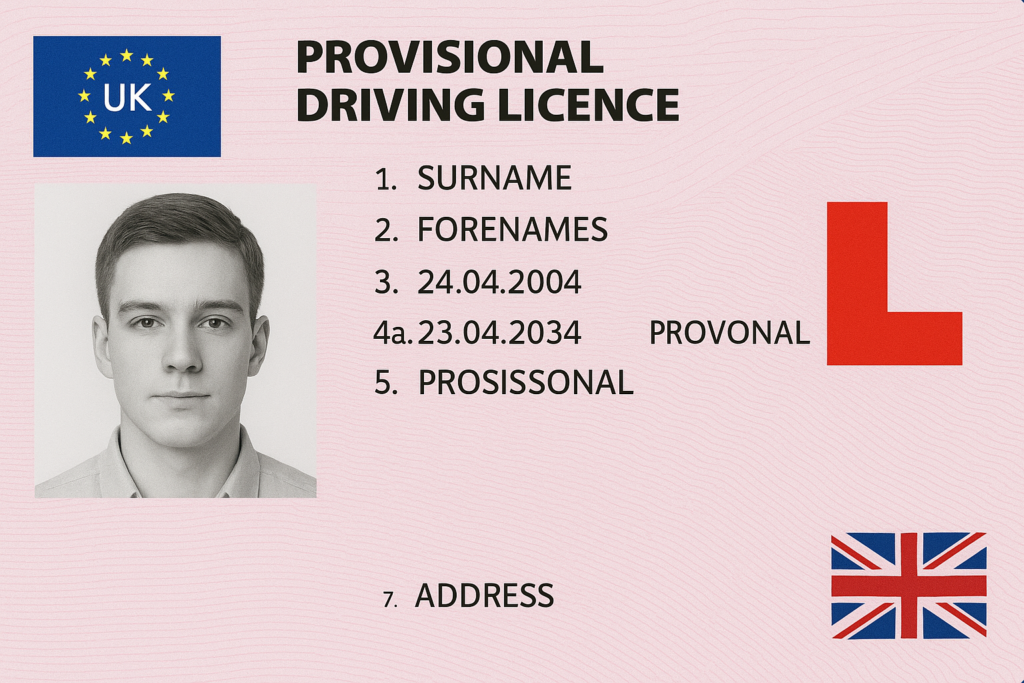
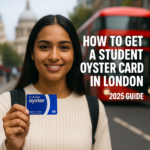

Pingback: How to Apply for a Student Oyster Card in London - Londonchit.com